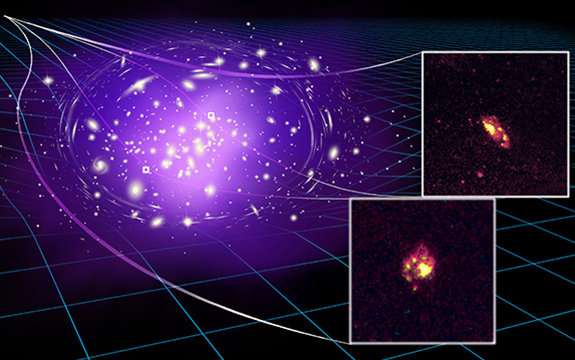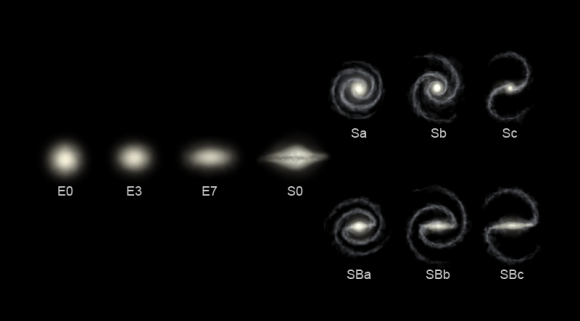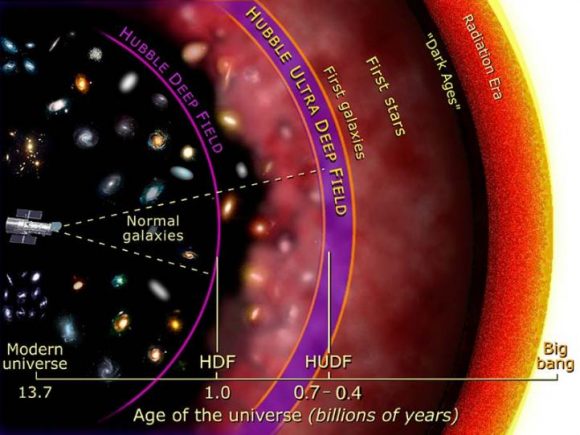Since the deployment of the Hubble Space Telescope, astronomers have been able to look deeper into the cosmic web than ever before. The farther they've looked, the deeper back in time they are able to see, and thus learn what the Universe looked like billions of years ago. With the deployment of other cutting-edge telescopes and observatories, scientists have been able to learn a great deal more about the history and evolution of the cosmos.
Most recently, an international team of astronomers using the Gemini North Telescope in Hawaii were able to spot a spiral galaxy located 11 billion light years away. Thanks to a new technique that combined gravitational lensing and spectrography, they were able to see an object that existed just 2.6 billion years after the Big Bang. This makes this spiral galaxy, known as A1689B11, the oldest and most distant spiral galaxy spotted to date.
The study which details the team's findings, titled "The most ancient spiral galaxy: a 2.6-Gyr-old disk with a tranquil velocity field", recently appeared in The Astrophysical Journal. The team consisted of members from the Swinburne University of Technology, the Australian Research Council Center of Excellence in All Sky Astrophysics in 3D (ASTRO 3D), the University of Lyon, Princeton University, and the Racah Institute of Physics at The Hebrew University in Jerusalem.

Spiral galaxy A1689B11 sits behind a massive cluster of galaxies that acts as a lens, producing two magnified images of the spiral galaxy in different positions in the sky. Credit: James Josephides
Together, the team relied on the gravitational lensing technique to spot A1689B11. This technique has become a mainstay for astronomers, and involves using a large object (like a galaxy cluster) to bend and magnify the light of a galaxy located behind it. As Dr. Tiantian Yuan, a Swinburne astronomer and the lead author on the research study, explained in a Swinburne press statement:
"This technique allows us to study ancient galaxies in high resolution with unprecedented detail. We are able to look 11 billion years back in time and directly witness the formation of the first, primitive spiral arms of a galaxy."
They then used the Near-infrared Integral Field Spectrograph (NIFS) on the Gemini North telescope to verify the structure and nature of this spiral galaxy. This instrument was built Peter McGregor of The Australian National University (ANU), which now is responsible for maintaining it. Thanks to this latest discovery, astronomers now have some additional clues as to how galaxies took on the forms that we are familiar with today.
Based on the classification scheme developed by famed astronomer Edwin Hubble (the "Hubble Sequence"), galaxies are divides into 3 broad classes based on their shapes - ellipticals, lenticulars and spirals - with a fourth category reserved for "irregularly-shaped" galaxies. In accordance with this scheme, galaxies start out as elliptical structures before branching off to become spiraled, lenticular, or irregular.

A figure illustrating the Hubble sequence, showing elliptical galaxies (left) and evolving to fit the three broad categories (right) of ellipticals, lenticulars and spirals. Credit: Ville Koistinen
As such, the discovery of such an ancient spiral galaxy is crucial to determining when and how the earliest galaxies began changing from being elliptical to taking on their modern forms. As Dr Renyue Cen, an astronomer from Princeton University and a co-author on the study, says:
"Studying ancient spirals like A1689B11 is a key to unlocking the mystery of how and when the Hubble sequence emerges. Spiral galaxies are exceptionally rare in the early Universe, and this discovery opens the door to investigating how galaxies transition from highly chaotic, turbulent discs to tranquil, thin discs like those of our own Milky Way galaxy."
On top of that, this study showed that the A1689B11 spiral galaxy has some surprising features which could also help inform (and challenge) our understanding of this period in cosmic history. As Dr. Yuan explained, these features are in stark contrast to galaxies as they exist today. But equally interesting is the fact that it also differentiates this spiral galaxy from other galaxies that are similar in age.
"This galaxy is forming stars 20 times faster than galaxies today – as fast as other young galaxies of similar masses in the early Universe," said Dr. Yuan. "However, unlike other galaxies of the same epoch, A1689B11 has a very cool and thin disc, rotating calmly with surprisingly little turbulence. This type of spiral galaxy has never been seen before at this early epoch of the Universe!"

Illustration of the depth by which Hubble imaged galaxies in prior Deep Field initiatives, in units of the Age of the Universe. Credit: NASA and A. Feild (STScI)
In the future, the team hopes to conduct further studies of this galaxy to further resolve its structure and nature, and to compare it to other spiral galaxies from this epoch. Of particular interest to them is when the onset of spiral arms takes place, which should serve as a sort of boundary marker between ancient elliptical galaxies and modern spiral, lenticular and irregular shapes.
They will continue to rely on the NIFS to conduct these studies, but the team also hopes to rely on data collected by the James Webb Space Telescope (which will be launched in 2019). These and other surveys in the coming years are expected to reveal vital information about the earliest galaxies in the Universe, and reveal further clues as to how it changed over time.
Further Reading: Swinburne, APJ
No comments:
Post a Comment